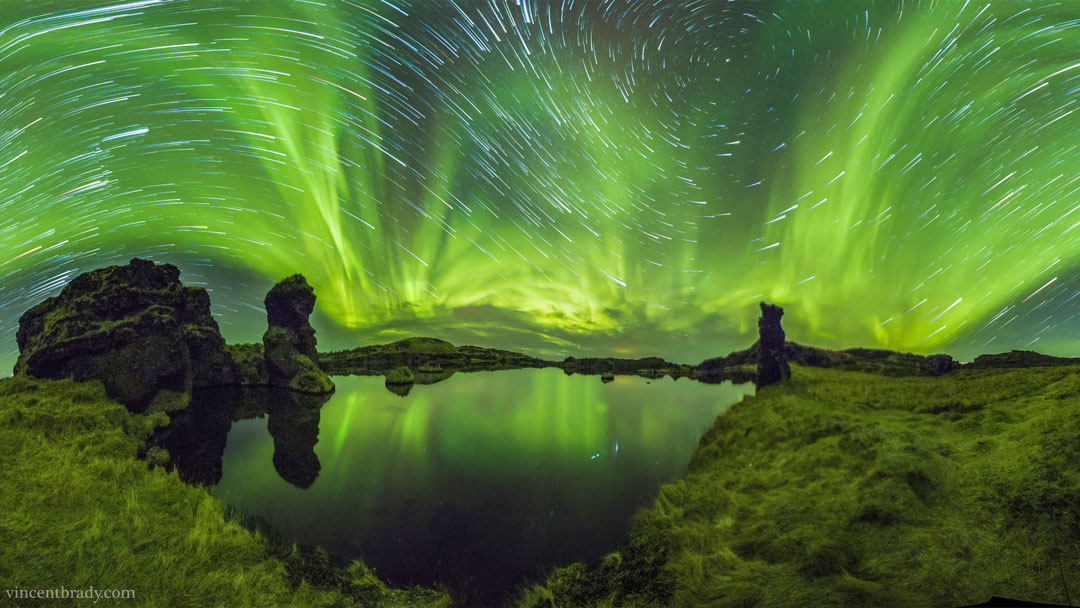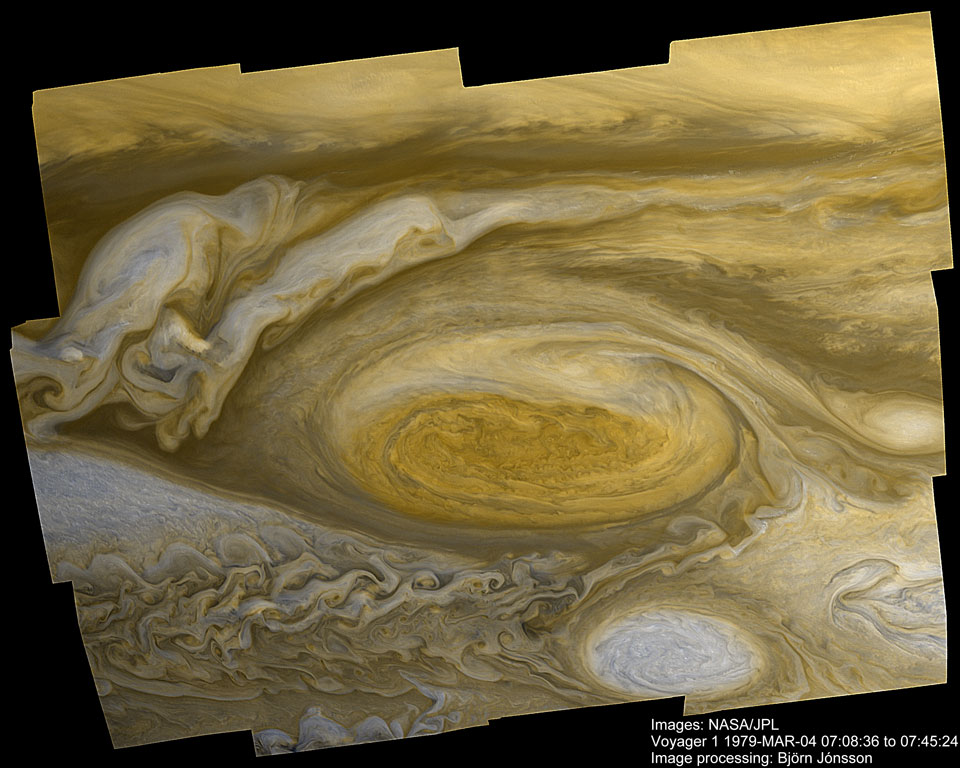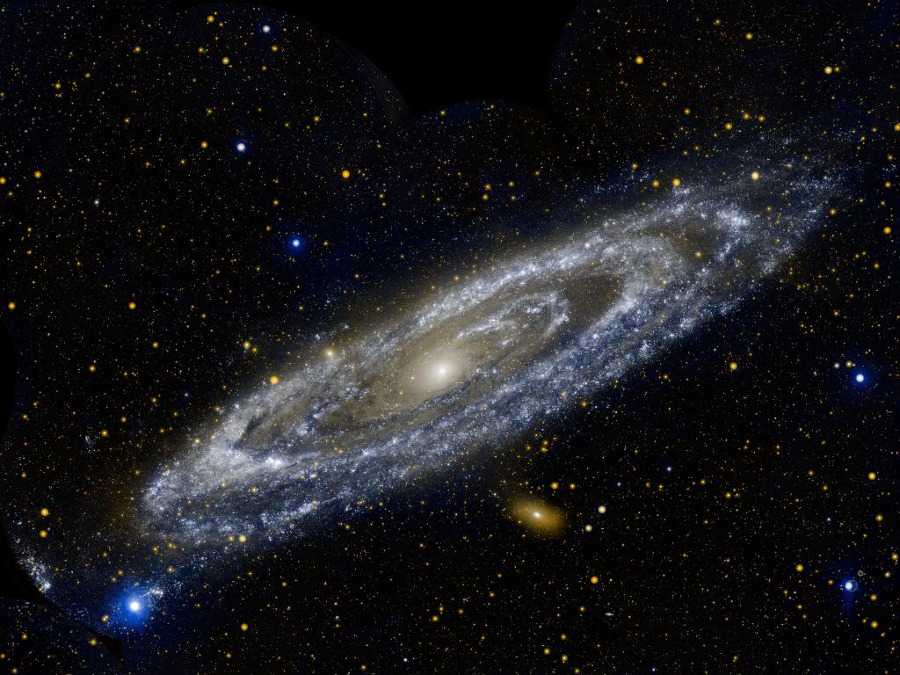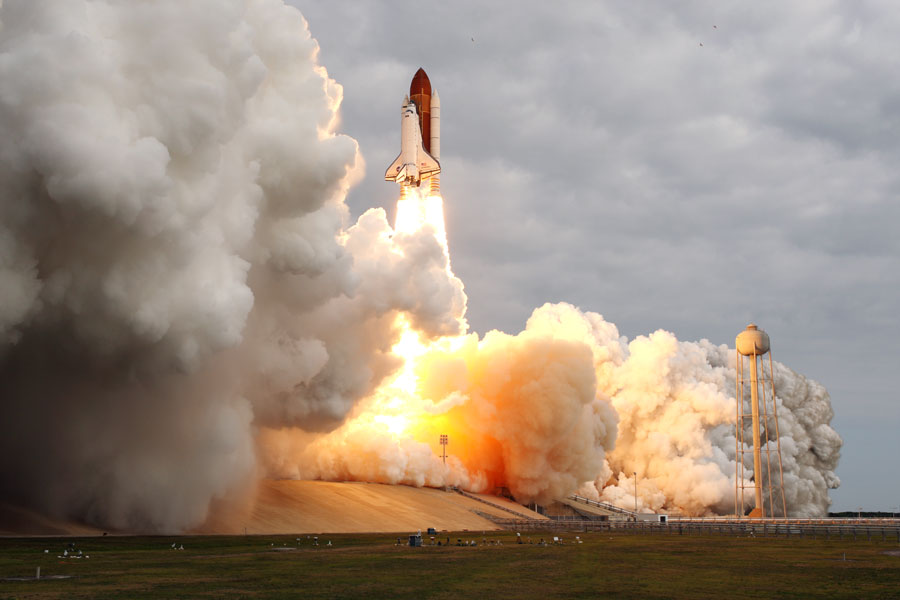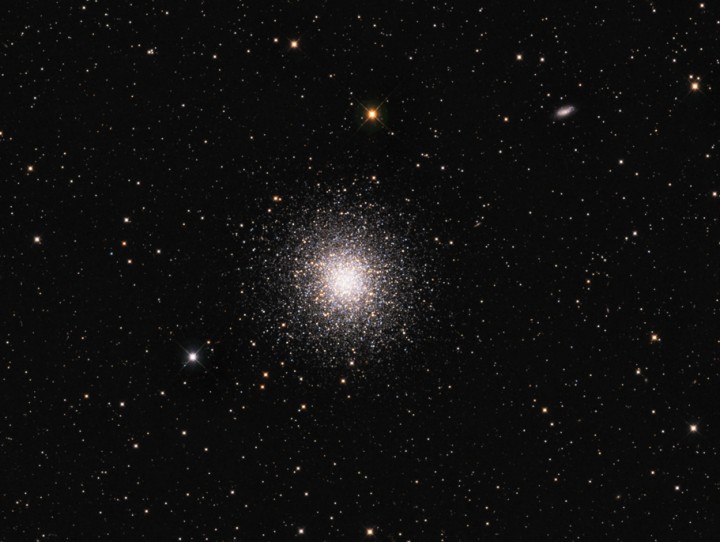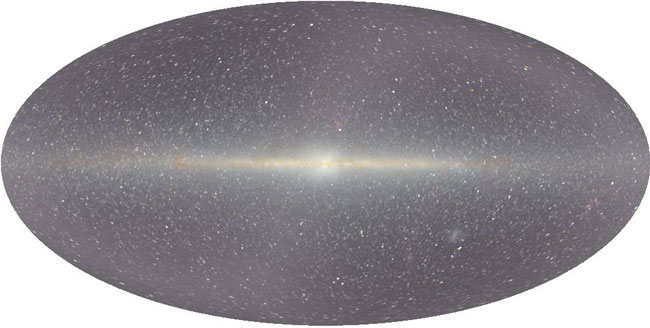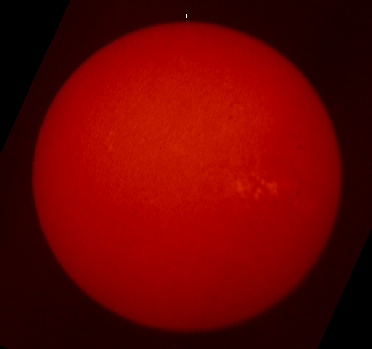| << Previous | Index | Next >> |
2015 It was one of the quietest nights of aurora in weeks. Even so, in northern- Iceland during last November, faint auroras lit up the sky every clear night. The featured 360-degree panorama is the digital fusion of four wide-angle cameras each simultaneously taking 101 shots over 42 minutes. In the foreground is serene Lake Myvatn dotted with picturesque rock formations left over from ancient lava flows. Low green auroras sweep across the sky above showing impressive complexity near the horizon. Stars far in the distance appear to show unusual trails -- as the Earth turned -- because early exposures were artificially faded.
2014 What will become of Jupiter's Great Red Spot? Recorded as shrinking since the 1930s, the rate of the Great Red Spot's size appears to have accelerated just in the past few years. A hurricane larger than Earth, the Great Red Spot has been raging at least as long as telescopes could see it. Like most astronomical phenomena, the Great Red Spot was neither predicted nor immediately understood after its discovery. Although small eddies that feed into the storm system seem to play a role, a more full understanding of the gigantic storm cloud remains a topic of continued research, and may result in a better understanding of weather here on Earth. The above image is a digital enhancement of an image of Jupiter taken in 1979 by the Voyager 1 spacecraft as it zoomed by the Solar System's largest planet. NASA's Juno spacecraft is currently heading toward Jupiter and will arrive in 2016.
2013 Once the famous sunset comet, PanSTARRS (C/2011 L4) is now visible all night from much of the northern hemisphere, bound for the outer solar system as it climbs high above the ecliptic plane. Dimmer and fading, the comet's broad dust tail is still growing, though. This widefield telescopic image was taken against the starry background of the constellation Cepheus on May 15. It shows the comet has developed an extensive anti-tail, dust trailing along the comet's orbit (to the left of the coma), stretching more than 3 degrees across the frame. Since the comet is just over 1.6 astronomical units from planet Earth, that corresponds to a distance of over 12 million kilometers. In late May Comet PanSTARRS will pass within a few degrees of the north celestial pole.
2012 A mere 2.5 million light-years away, the Andromeda Galaxy really is just next door as large galaxies go. So close, and spanning some 260,000 light-years, it took 11 different image fields from the Galaxy Evolution Explorer (GALEX) satellite's telescope to produce this gorgeous portrait of the spiral galaxy in ultraviolet light. While its spiral arms stand out in visible light images of Andromeda (also known as M31), the arms look more like rings in the GALEX ultraviolet view, dominated by hot, young, massive stars. As sites of intense star formation, the rings have been interpreted as evidence Andromeda collided with its smaller neighboring elliptical galaxy M32 more than 200 million years ago. The large Andromeda galaxy and our own Milky Way are the dominant members of the local galaxy group.
2011 Two days ago, powerful yet controlled explosions rocketed the Space Shuttle Endeavour on its final trip into Earth orbit. The above image was taken seconds after liftoff as the massive orbiter and six astronauts began a climb to a height where the atmosphere is so thin it is unbreathable. The shuttle, on mission STS-134, is expected to dock with the International Space Station (ISS) today. The Endeavour will deliver to the ISS, among other things, an ambitious detector called the Alpha Magnetic Spectrometer 2 (AMS), a detector that over the next few years could detect a significant abundance of specific types of dark matter, charged antimatter, and even a strangely possible variation of familiar matter called strangelets. The very last trip for any space shuttle is currently planned for mid-July when Atlantis will also visit the space station.
2010
2009 What's happening over that castle? While waiting for the Moon to rise last month in Thurso, Scotland, amateur astrophotographer Stewart Watt took a three minute exposure of the background stars. The above image was the surprising result. Patchy clouds in front of the rising moon created crepuscular rays streaming across the night sky in spectacular fashion. In the foreground is a stone tower from Thurso Castle, a 12th century fortress augmented in the 17th century. Above the crepuscular moon rays are stars, many from the constellation of the Lion (Leo). Visible to the right of the tower is the planet Saturn.
2008 Where did the gold in your jewelry originate? No one is completely sure. The relative average abundance in our Solar System appears higher than can be made in the early universe, in stars, and even in typical supernova explosions. Some astronomers have recently suggested that neutron-rich heavy elements such as gold might be most easily made in rare neutron-rich explosions such as the collision of neutron stars. Pictured above is an artist's illustration depicting two neutron stars spiraling in toward each other, just before they collide. Since neutron star collisions are also suggested as the origin of short duration gamma-ray bursts, it is possible that you already own a souvenir from one of the most powerful explosions in the universe.
2007 In 1714, Edmond Halley noted that M13 "shows itself to the naked eye when the sky is serene and the Moon absent." Of course, M13 is now modestly recognized as the Great Globular Cluster in Hercules, one of the brightest globular star clusters in the northern sky. Telescopic views reveal the spectacular cluster's hundreds of thousands of stars. At a distance of 25,000 light-years, the cluster stars crowd into a region 150 light-years in diameter, but approaching the cluster core upwards of 100 stars could be contained in a cube just 3 light-years on a side. For comparison, the closest star to the Sun is over 4 light-years away. Along with the cluster's dense core, the outer reaches of M13 are highlighted in this deep color image. A distant background galaxy, NGC 6207 is also visible above and to the right of the Great Globular Cluster M13.
2006 An alluring sight in dark southern skies, the Large Magellanic Cloud (LMC) is seen here through a narrow filter that transmits only the red light of hydrogen atoms. Ionized by energetic starlight, a hydrogen atom emits the characteristic red H-alpha light as its single electron is recaptured and transitions to lower energy states. As a result, this image of the LMC seems covered with shell-shaped clouds of hydrogen gas surrounding massive, young stars. Sculpted by the strong stellar winds and ultraviolet radiation, the glowing hydrogen clouds are known as H II (ionized hydrogen) regions. This high resolution mosaic view was recorded in 6 segments, each with 200 minutes of exposure time. Itself composed of many overlapping shells, the Tarantula Nebula, is the large star forming region near top center. A satellite of our Milky Way Galaxy, the LMC is about 15,000 light-years across and lies a mere 180,000 light-years away in the constellation Dorado.
2005 What did the Huygens probe see as it descended toward Saturn's Moon Titan? In January the robot Cassini spacecraft now orbiting Saturn released a probe through the dense cloud decks of one of the Solar System's most mysterious moons. Below the clouds, as it descended, the probe took images of the approaching surface as well as several images from the surface itself. Many of the images have now been digitally merged and scaled into the above perspective from 3,000 meters high. The above stereographic projection shows a 360-degree wide-angle view of the surface of Titan. The bright areas toward the top and left of the image are thought to be relatively high ground laced with drainage channels cut by rivers of methane. The bright shapes on the right are now hypothesized to be ridges of ice gravel. Huygen's landing site, labeled, appears to be on a type of dark dry lakebed, once fed by a large dark flow channel on the left. The Huygen's probe lasted an unexpectedly long three hours on Titan's harsh surface.
2004 Comet NEAT (Q4) was quite photogenic earlier this month. Although the head and part of the tails of Comet C/2001 Q4 (NEAT) were visible to the unaided eye, the best views of the colorful tail were revealed only later by cameras able to expose for long periods. A human eye can accumulate light for up to 1/10th of a second, as opposed to the above camera image, which used an exposure of thirty seconds on May 8. Visible is a long blue ion tail, a blue coma surrounding the comet's nucleus, and a shorter but brighter sunlight reflecting dust tail. Q4 is dropping more from easy visibility each day as it recedes from both the Earth and the Sun. Another separate naked-eye comet, Comet LINEAR (T7), should remain bright into June.
2003 Is this image worth a thousand words? According to the Holographic Principle, the most information you can get from this image is about 3 x 1065 bits for a normal sized computer monitor. The Holographic Principle, yet unproven, states that there is a maximum amount of information content held by regions adjacent to any surface. Therefore, counter-intuitively, the information content inside a room depends not on the volume of the room but on the area of the bounding walls. The principle derives from the idea that the Planck length, the length scale where quantum mechanics begins to dominate classical gravity, is one side of an area that can hold only about one bit of information. The limit was first postulated by physicist Gerard 't Hooft in 1993. It can arise from generalizations from seemingly distant speculation that the information held by a black hole is determined not by its enclosed volume but by the surface area of its event horizon. The term "holographic" arises from a hologram analogy where three-dimension images are created by projecting light though a flat screen. Beware, other people looking at the above image may not claim to see 3 x 1065 bits -- they might claim to see a teapot.
2002 How far can you see? The most distant object easily visible to the unaided eye is M31, the great Andromeda Galaxy some two million light-years away. Without a telescope, even this immense spiral galaxy appears as an unremarkable, faint, nebulous cloud in the constellation Andromeda. But a bright yellow nucleus, dark winding dust lanes, gorgeous blue spiral arms and star clusters are recorded in this stunning telescopic digital mosaic of the nearby island universe. While even casual skygazers are now inspired by the knowledge that there are many distant galaxies like M31, astronomers seriously debated this fundamental concept only 80 years ago. Were these "spiral nebulae" simply outlying components of our own Milky Way Galaxy or were they instead "island universes" -- distant systems of stars comparable to the Milky Way itself? This question was central to the famous Shapley-Curtis debate of 1920, which was later resolved by observations of M31 in favor of Andromeda, island universe.
2001
2000 Was this picture taken from outside our Galaxy? No, it is a composite taken from Earth orbit, well inside our Milky Way Galaxy. In light just a little too red for human eyes to see - "near infrared" electromagnetic radiation - the disk and center of our Galaxy stand out giving an appearance likely similar to seeing our Galaxy from the outside in visible light. The above COBE image was recently reprocessed for higher resolution and shows red stars and dust in our Galaxy superposed against the faint glow of many dim stars in distant galaxies. Faintly visible as an S-shaped sash running through the image center is zodiacal light -- dust in our own Solar System. Compared to the far-infrared sky, little Galactic dust is visible. The two smudges on the lower right are the Large and Small Magellanic Clouds neighboring galaxies.
1999 High above Laguna Beach last month hung bright celestial orbs. Visible after the California sunset were, from left to right, the Moon, Saturn, and Venus. Tonight and for the next few days, Venus and the Moon will again be visible together. Nearby stars will include Pollux, Castor, and Procyon. Venus now sets hours after the Sun and is so bright it might be mistaken for an airplane or UFO. Binoculars should enable the viewing of craters on the Moon, and phases for Venus.
1998 Why isn't the star in the center of the nebula? NGC 6369 appears to be a fairly ordinary planetary nebula. It can be seen with a good telescope in the constellation of Ophiuchus. The gas expelled by the central star is bunched in the shape of a donut or cylinder. During the planetary nebula phase, the central star sheds its outer atmosphere as it is evolving to become a white dwarf star. The above image was taken with the Hubble Space Telescope. A closer look at NGC 6369 indicates that the central star is closer to a dimmer edge of the nebula than to the opposing brighter edge.
1997 The first US spacecraft was Explorer 1. The cylindrical 30 pound satellite was launched (above) as the fourth stage of a Jupiter-C rocket (a modified US Army Redstone ballistic missile) and achieved orbit on January 31, 1958. Explorer I carried instrumentation to measure internal and external temperatures, micrometeorite impacts, and an experiment designed by James A. Van Allen to measure the density of electrons and ions in space. The measurements made by Van Allen's experiment led to an unexpected and startling discovery -- an earth-encircling belt of high energy electrons and ions trapped in the magnetosphere now known as the Van Allen Belt. Explorer I ceased transmitting on February 28 of that year but remained in orbit until March of 1970.
1996 Our Sun shows a different face every day. The above picture was taken on May 15, but a similar picture of the Sun actually taken today can be found here. The above picture was taken in red light and so is shown in red. The bright spots to the right of center are active regions known as plages. Currently, the Sun is showing very few active regions or sunspots, and is considered to be in a solar minimum. Solar activity will pick up over the next six years until a "solar maximum" is reached. The Sun goes through this cycle of maxima and minima every 11 years. Sol, our Sun, is hundreds of times more massive than all the planets in the Solar System combined. However, the Sun itself contains only a small amount of the total angular momentum of the Solar System.
| << Previous | Index | Next >> |
